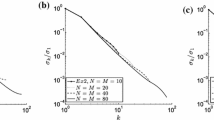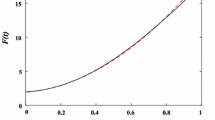Abstract
We consider the inverse problem for the wave equation which consists in determining an unknown space-dependent force function acting on a vibrating structure from Cauchy boundary data. Since only boundary data are used as measurements, the study has given importance and significance to non-intrusive and non-destructive testing of materials. This inverse force problem is linear, and the solution is unique, but the problem is still ill-posed since, in general, the solution does not exist and, even if it exists, it does not depend continuously on the input data. Numerically, the finite-difference method combined with Tikhonov regularization is employed in order to obtain a stable solution. Several orders of regularization are investigated. The choice of the regularization parameter is based on the L-curve method. Numerical results show that the solution is accurate for exact data and stable for noisy data. An extension to the case of multiple additive forces is also addressed. In a companion paper, in Part II [J Eng Math 2015, this volume], the time-dependent force identification will be undertaken.


















Similar content being viewed by others
References
Cannon JR, Dunninger DR (1970) Determination of an unknown forcing function in a hyperbolic equation from overspecified data. Annali di Matematica Pura ed Applicata 1:49–62
Engl HW, Scherzer O, Yamamoto M (1994) Uniqueness and stable determination of forcing terms in linear partial differential equations with overspecified boundary data. Inverse Probl 10:1253–1276
Klibanov MV (1992) Inverse problems and Carleman estimates. Inverse Probl 8:575–596
Puel J-P, Yamamoto M (1996) On a global estimate in a linear hyperbolic problem. Inverse Probl 12:995–1002
Yamamoto M (1995) Stability, reconstruction formula and regularization for an inverse source hyperbolic problem by a control method. Inverse Probl 11:481–496
Hussein SO, Lesnic D (2014) Determination of a space-dependent source function in the one-dimensional wave equation. Electron J Bound Elem 12:1–26
Hansen PC (2001) The L-curve and its use in the numerical treatment of inverse problems. In: Johnston P (ed) Computational inverse problems in electrocardiology. WIT Press, Southampton, pp 119–142
Romanov VG (1986) Inverse problems of mathematical physics. VNU Press, Utrecht
Beilina L, Klibanov MV (2012) Approximate global convergence and adaptivity for coefficient inverse problems. Springer, New York
Klibanov MV (2013) Carleman estimates for global uniqueness, stability and numerical methods for coefficient inverse problems. J Inverse Ill-Posed Probl 21:477–560
Lions JL (1971) Optimal control of systems governed by partial differential equations. Springer, New York
Lions JL (1988) Exact controllability, stabilization and perturbations for distributed systems. SIAM Rev 30:1–68
Smith GD (1985) Numerical solution of partial differential equations: finite difference methods, 3rd edn. Clarendon Press, Oxford
Twomey S (1963) On the numerical solution of Fredholm integral equations of first kind by inversion of the linear system produced by quadrature. J Assoc Comput Mach 10:97–101
Hussein SO, Lesnic D, Determination of forcing functions in the wave equation. Part II: the time-dependent case. J Eng Math (this volume)
Acknowledgments
S. O. Hussein would like to thank the Human Capacity Development Programme (HCDP) in Kurdistan for their financial support. The comments and suggestions made by the referees are gratefully acknowledged.
Author information
Authors and Affiliations
Corresponding author
Rights and permissions
About this article
Cite this article
Hussein, S.O., Lesnic, D. Determination of forcing functions in the wave equation. Part I: the space-dependent case. J Eng Math 96, 115–133 (2016). https://doi.org/10.1007/s10665-015-9785-y
Received:
Accepted:
Published:
Issue Date:
DOI: https://doi.org/10.1007/s10665-015-9785-y




